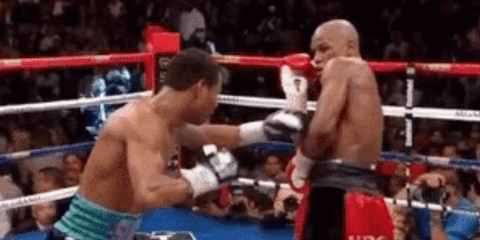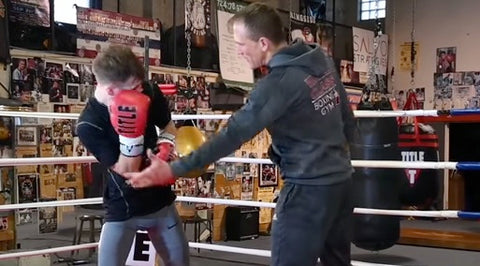Crack the Code of Philly Shell Defense: Transform Your Boxing Style
The Philly Shell defense, also known as the shoulder roll, is a strategic defensive technique used by boxers to protect themselves from incoming punches while maintaining the ability to counter effectively.
In today's blog post, we'll delve into the intricacies of the Philly Shell defense, including its execution, practice methods, strengths, and weaknesses.
What Is The Philly Shell Defense?
The Philly Shell defense, also known as the shoulder roll, is a strategic defensive technique employed by boxers to protect themselves from incoming punches while maintaining the ability to counter.

It is characterized by tucking the chin, raising the lead shoulder to shield the jaw, and positioning the rear hand to cover the body. This defensive posture not only offers protection against opponents' punches but also allows fighters to conserve energy and maintain balance, enabling them to seamlessly transition between defense and offense in the heat of combat.
Mastering the Philly Shell defense requires discipline, dedication, and a thorough understanding of defensive principles. To develop these skills and traits, you need to have a boxer’s mentality.
How To Perform The Philly Shell Defense:
Mastering the Philly Shell defense demands meticulous attention to form and technique.
Begin by assuming a boxing stance, feet shoulder-width apart, knees slightly bent, and weight evenly distributed. Position your lead arm across your torso, placing it somewhere between your belly button and chest, with your lead hand touching your opposite side.
Simultaneously, position your rear hand close to your face, ready to defend against incoming jabs and hooks. Keep your rear hand poised to block or parry punches, maintaining a protective barrier around your head and body.
Elevate your lead shoulder to the lower part of your face, forming an additional line of defense against straight rights and hooks. This defensive posture requires fluid movement and quick reflexes to effectively neutralize your opponent's attacks.
Maintain a relaxed yet vigilant stance, allowing for seamless defensive maneuvers and swift counter-attacks. Practice shifting your weight smoothly between your feet, enabling dynamic movement and evasive actions.
By mastering the fundamentals of the Philly Shell defense, you can effectively protect yourself from incoming blows while setting up strategic counter-offensives to dominate your opponent in the ring.
How To Practice The Philly Shell Defense:
Mastering the Philly Shell defense necessitates dedicated practice and repetition.
Start with shadowboxing drills, focusing on perfecting your form and defensive posture. Gradually progress to partner drills and sparring sessions, where you can test your defensive skills in simulated combat scenarios. Pay close attention to your positioning, timing, and reactions to incoming punches, and continually refine your technique based on feedback from trainers and sparring partners.
1. Shadowboxing Drills:
Begin your practice by incorporating shadowboxing drills into your training regimen. Shadowboxing allows you to visualize your opponent's movements and practice the defensive techniques associated with the Philly Shell stance. Focus on maintaining proper form, including tucking your chin, raising the lead shoulder, and positioning the rear hand to cover the body. Practice moving in and out of the Philly Shell stance fluidly, simulating different defensive scenarios and counter-attacking opportunities.
2. Partner Drills:
Once you've mastered the basics through shadowboxing, progress to partner drills with a coach or training partner. Work on defensive drills where your partner throws punches at varying speeds and angles, allowing you to practice reacting and deflecting blows with the Philly Shell defense. Incorporate counter-punching opportunities into these drills, utilizing openings created by your defensive posture to launch precise, powerful strikes in response to your partner's strikes.
3. Sparring Sessions:
Sparring is an essential component of practicing the Philly Shell defense in a live combat setting. Engage in controlled sparring sessions with partners of varying skill levels to test your defensive skills under pressure. Focus on maintaining your defensive posture while actively looking for opportunities to counter-attack. Pay close attention to your footwork, positioning, and timing, as these elements play a crucial role in effectively implementing the Philly Shell defense against your opponents.
4. Focused Repetition:
Consistent repetition is key to mastering the Philly Shell defense. Dedicate specific training sessions to focused repetition of defensive techniques, including drills to improve your reflexes, timing, and defensive instincts. Practice transitioning seamlessly between defensive and offensive strategies, ensuring that you can maintain your defensive stance while capitalizing on counter-attacking opportunities.
Philly Shell Defense Weaknesses:
While the Philly Shell defense is highly effective, it is not without its weaknesses. Understanding and addressing these weaknesses is crucial for boxers looking to incorporate this defensive technique.
1. Vulnerability to Body Shots:
One of the primary weaknesses of the Philly Shell defense is its susceptibility to body shots. While the lead shoulder protects the jaw, the midsection remains exposed to punches aimed at the body. Boxers utilizing the Philly Shell must be mindful of this vulnerability and employ additional defensive tactics to mitigate the risk of body shots. This may include incorporating subtle movements to protect the midsection or actively countering body shots with strategic defensive maneuvers.
2. Limited Mobility:
The defensive posture of the Philly Shell can sometimes restrict mobility, particularly when transitioning between defensive and offensive positions. Boxers must be cautious not to become overly reliant on the Philly Shell stance, as it may hinder their ability to move fluidly and adapt to changing situations in the ring. To overcome this limitation, boxers should focus on developing agile footwork and maintaining optimal positioning to maximize their mobility while utilizing the Philly Shell defense.
3. Skill and Timing Requirements:
Executing the Philly Shell defense with precision requires a high level of skill and timing. Novice fighters may struggle to master the intricacies of the Philly Shell. Additionally, timing is critical when utilizing the Philly Shell to deflect punches and launch counter-attacks effectively. Novice fighters may need to spend additional time honing their fundamental defense and refining their timing before confidently implementing the Philly Shell in live combat situations.
Philly Shell Masters:
In boxing, the mastery of defensive techniques often distinguishes the great from the legendary.
Among these techniques, the Philly Shell defense stands as a testament to the artistry and skill of its practitioners. In this exploration of Philly Shell Masters, we delve into the lives and legacies of iconic fighters who have elevated this defensive style to unparalleled heights.
1. Floyd Mayweather Jr:
Renowned as one of the most accomplished defensive tacticians in boxing history, Floyd Mayweather Jr. stands as the epitome of Philly Shell mastery. Popularizing the Philly Shell in the modern era, Mayweather Jr. utilized impeccable timing and reflexes to evade opponents' strikes while effortlessly transitioning from defense to offense.
2. George Benton:
Regarded as a true master of the shoulder roll, George Benton refined the defensive tactic in the 1950s with his slick defensive abilities and overall fluidity in the ring. His astute understanding of defensive positioning and counter-punching made him a formidable force inside the squared circle.
3. James Toney:
A true throwback to the golden age of boxing, James Toney mesmerized audiences with his old-school style and defensive prowess. Mastering the Philly Shell defense, Toney seamlessly flowed from defense to attack, utilizing elusive in-fighting and devastating counter shots to outwit his adversaries.
If You Liked This, You May Also Like…
- STYLES OF BOXING: PRESSURE FIGHTING
- ORIGINS OF THE PHILLY SHELL / SHOULDER ROLL
- HOW TO DOMINATE YOUR OPPONENT BEFORE THE FIGHT EVEN STARTS
Summary.
The Philly Shell defense is a versatile and potent defensive technique that can significantly enhance a boxer's defensive repertoire. By mastering the fundamentals of the Philly Shell, including proper form, timing, and defensive tactics, fighters can become elusive and challenging targets in the ring.
However, it's essential to recognize the strengths and weaknesses of the Philly Shell and continuously refine and adapt your defensive strategy to suit the demands of each fight. With dedication, practice, and a keen understanding of defensive principles, mastering the Philly Shell defense can elevate your boxing game to new heights, providing a formidable shield against opponents' attacks while creating opportunities for strategic counter-offensives.
Want more boxing tips and news? Check out our full list of articles here.
GET THE MOST OPTIMIZED JUMP ROPE FOR BOXING.
Looking for the best jump rope for boxing?
Built from a high-grade PVC rope, it weighs about 15% more and is wound 20% tighter than traditional jump ropes. The added weight and tightness create a satisfying and natural feel.
The BoxRope Vol.1. added agility and control allow you to create superior workouts and achieve greater results. It is simply the finest rope available, and we know you’re going to love it.
If your game to the next level, click here to get the best jump rope for boxing.


